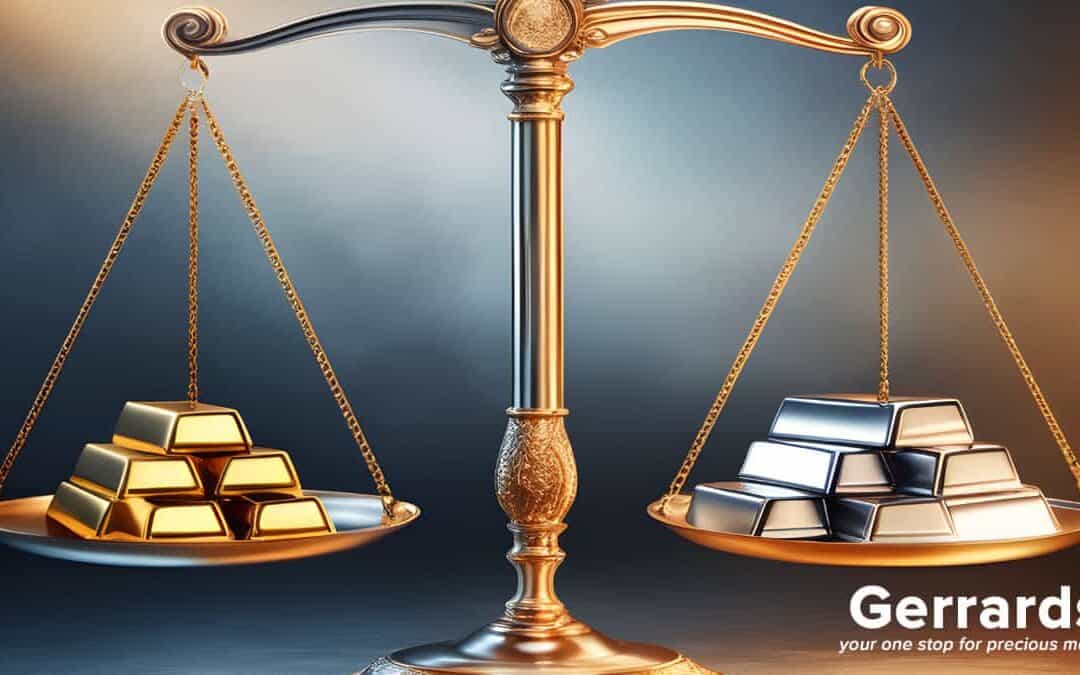The allure of precious metals has captivated humans for millennia. Among these, gold and silver stand out not just for their lustrous beauty but also for their enduring value. In the world of investments, these metals are more than just commodities; they are symbols of wealth and stability, transcending the volatility of traditional financial markets.
This article delves into the intricate world of gold and silver. Whether you’re contemplating your first investment in precious metals or seeking to diversify an already robust portfolio, understanding the unique characteristics and market dynamics of gold and silver is crucial.
We’ll uncover the historical significance, market behaviours, and investment strategies for both gold and silver. By comparing their performance, risks, and rewards, this comprehensive guide aims to provide you with the insights needed to make informed decisions. Which metal is the right choice for your investment portfolio? Let’s find out.
The Timeless Appeal of Gold
Historical Significance
Gold, often revered as the king of metals, has a storied history that intertwines with the development of civilizations. Its discovery and subsequent use in jewellery, coinage, and artifacts date back to ancient times. Throughout various cultures and eras, gold has been a symbol of power, beauty, and wealth. Its significance extends beyond mere ornamentation; gold has been a cornerstone in monetary systems, influencing economies and trade routes.
The fascination with gold has endured through centuries, transcending geographical and cultural boundaries. Its role in shaping human history is profound, with pivotal moments like the Egyptian pharaohs’ obsession with gold, the Roman Empire’s extensive use of gold coins, and the famous California Gold Rush of the 19th century. These historical events highlight gold’s unwavering appeal and its impact on societal development.

Gold as an Investment
When it comes to investing, gold has a reputation for being a safe haven asset. Its value tends to remain stable or even increase during times of economic uncertainty or inflation, making it a popular choice for risk-averse investors. Unlike stocks and bonds, gold’s worth is not tied to the performance of a particular company or government, giving it a unique standing in the investment world.
The price of gold is influenced by various factors, including global economic conditions, currency values, and supply and demand dynamics. Investors often turn to gold during economic downturns, as it typically holds its value better than other assets. Additionally, gold’s scarcity and the cost of mining add to its value, ensuring that it remains a sought-after asset.
Investing in gold can take several forms, including physical gold (like coins and bars), gold exchange-traded funds (ETFs), gold mutual funds, and stocks in gold mining companies. Each of these investment vehicles has its characteristics, with factors like storage, liquidity, and exposure to market fluctuations playing a crucial role in an investor’s decision-making process.
Pros and Cons of Investing in Gold
Investing in gold comes with its set of advantages and challenges. On the plus side, gold is an excellent diversification tool. Its price movements are often uncorrelated with those of other assets like stocks and bonds, providing a hedge against market volatility. Gold’s historical performance during periods of inflation or currency devaluation further bolsters its appeal as a protective investment.
However, investing in gold is not without its drawbacks. One of the main criticisms is that gold does not produce income like dividends or interest. This means that the return on investment relies solely on price appreciation, which can be unpredictable. Physical gold requires secure storage and insurance, adding to the costs of investment. For gold stocks and ETFs, the risks include market volatility and management fees.
Despite these challenges, its role as a financial safe haven continue to attract investors. Its ability to act as a hedge against inflation and economic uncertainty makes it a staple in many investment portfolios. Whether you’re a casual investor seeking stability or a seasoned collector diversifying assets, gold’s timeless appeal remains undeniable.
The Versatile World of Silver
Historical Significance
Silver, often dubbed the “common man’s gold,” has played a crucial role throughout history, both in terms of economic and cultural significance. Its discovery dates back to ancient times, paralleling that of gold, but with more abundant deposits, silver was more accessible and widely used. This accessibility made silver a popular choice for coinage and everyday trade, establishing it as a key player in early monetary systems.
The historical narrative of silver is rich and varied. From its use in ancient Greek and Roman empires as currency to the flourishing trade routes during the Age of Exploration fueled by silver, this metal has been a constant in human economic activity. Notable periods like the Spanish conquest of the New World led to a massive influx of silver, profoundly affecting global economies and trade.
The unique properties of silver, including its conductivity, malleability, and reflectivity, have also made it valuable in various applications beyond currency. Its use in jewelry, tableware, and, more recently, in industrial and technological applications, showcases its versatility and ongoing relevance.
Silver in the Modern Market
In the contemporary investment landscape, silver’s role is multifaceted. While it shares some investment characteristics with gold, such as being a hedge against inflation and economic uncertainty, silver’s price is also heavily influenced by its industrial demand. This demand comes from sectors like electronics, solar energy, and medicine, where silver’s physical properties are indispensable.
The price of silver tends to be more volatile than gold due to its smaller market and the dual influence of investment and industrial demand. This volatility can present opportunities for higher returns, but it also introduces greater risk. Silver’s lower price point compared to gold makes it an accessible entry for new investors and allows for more flexibility in terms of investment size.
Like gold, silver can be invested in through various avenues, including physical silver (coins, bars), silver ETFs, mutual funds, and stocks in silver mining companies. This variety provides investors with multiple options to tailor their silver investments according to their risk tolerance, investment goals, and interests in the physical or stock market aspects of silver trading.
Silver in the Modern Market
Investing in silver comes with its unique set of advantages and challenges. On the upside, silver’s industrial demand provides a strong foundation for its value, and its affordability compared to gold makes it an attractive option for diversifying investment portfolios. The potential for higher volatility can also translate into greater short-term gains for investors.
However, the very factors that can lead to higher gains also introduce risks. Silver’s price is more susceptible to economic changes and industrial demand fluctuations, making it potentially more unpredictable than gold. For those holding physical silver, issues such as storage, insurance, and lower liquidity compared to gold can be a concern.
Despite these challenges, silver remains a popular choice among investors for its affordability, diverse applications, and potential for growth. Its role in the modern market, influenced by both traditional investment dynamics and industrial demand, makes it a unique and compelling option for investors and collectors.
Comparative Analysis
Market Performance Comparison
When comparing gold and silver, it’s crucial to understand their market performance characteristics. Gold is often perceived as a more stable investment, with less volatility in its price movements. This stability is partly due to its status as a safe-haven asset, where investors flock during times of economic uncertainty. Gold’s price is less influenced by industrial demand, making it more resilient to economic downturns.
Silver, in contrast, exhibits more price volatility. Its dual role as an investment and industrial metal means that its price is affected by both investment demand and industrial usage. While this can lead to higher peaks and lower troughs in price, it also presents opportunities for investors to capitalize on these fluctuations. The smaller market size for silver compared to gold also contributes to its higher volatility.
In terms of long-term performance, both metals have shown an ability to retain value, but their growth trajectories differ. Gold has consistently maintained its value over the centuries, while silver’s price has experienced more dramatic ups and downs, reflective of its dual nature and smaller market.

Risk vs. Reward
The risk-reward profile of gold and silver is an essential consideration for investors. Gold, with its reputation for stability and ability to maintain value, is often seen as a lower-risk investment. This makes it a preferred choice for those looking to preserve capital and protect against inflation and economic instability.
Silver, on the other hand, offers a potentially higher reward due to its price volatility. This volatility can be advantageous for investors looking for short-term gains or those who are adept at timing the market. However, it also means higher risk, as silver’s price can fluctuate significantly in response to changes in industrial demand and economic conditions.
Investors must weigh these factors based on their risk tolerance, investment horizon, and financial goals. Those seeking stability and long-term value retention may lean towards gold, while those willing to take on more risk for the potential of higher returns might find silver more appealing.
Investment Strategies for Gold and Silver
Investment strategies for gold and silver can vary greatly depending on individual goals and market conditions. For gold, a common strategy is long-term holding, capitalizing on its stability and potential for gradual appreciation. Investors might also consider gold ETFs and mutual funds for easier liquidity and diversification.
Silver investors might adopt a more active trading approach, leveraging its price volatility. This could involve timing the market to buy low and sell high, or investing in silver ETFs and stocks of companies involved in silver mining and processing. Diversifying within the silver market – across physical silver, stocks, and funds – can also help mitigate some of the risks associated with its volatility.
Both gold and silver can play a role in a balanced investment portfolio. While gold can act as a stabilizing force, silver can offer growth potential, especially in a bullish market. The key is to understand how each fits into your overall investment strategy and risk profile.
Factors to Consider Before Investing
Economic Indicators
When considering an investment in gold or silver, it’s crucial to understand the economic indicators that can influence their prices. Factors such as inflation rates, interest rates, and currency values play a significant role. For instance, higher inflation often boosts the appeal of gold as a hedge against the eroding value of fiat currencies. Similarly, low-interest rates can make gold more attractive, as the opportunity cost of holding a non-yielding asset decreases.
Silver’s price is additionally influenced by industrial demand, which can be affected by overall economic health. During periods of strong industrial growth, the demand for silver can increase, potentially driving up its price. Conversely, an economic downturn might reduce industrial demand, impacting silver prices negatively. Monitoring these economic indicators can provide valuable insights into potential price movements of both metals.

Diversification and Balance
Diversification is a key principle in investment. While both are valuable assets, they should be part of a broader, diversified investment portfolio. Gold can provide stability and act as a hedge against inflation, while silver can offer growth potential and add diversity due to its industrial applications.
Balancing your investment in gold and silver with other asset classes like stocks, bonds, and real estate can help mitigate risk and enhance overall portfolio performance. The exact allocation will depend on your individual risk tolerance, investment goals, and market outlook. It’s also important to regularly review and adjust your investment mix to maintain a balanced and diversified portfolio that reflects changing market conditions and personal circumstances.
Predictions and Trends
Future Outlook
Predicting the future market behavior of gold and silver is challenging, as it depends on various global economic, political, and industrial factors. However, many experts suggest that gold will continue to be a safe haven, particularly in times of economic uncertainty. The increasing geopolitical tensions, inflationary pressures, and fluctuations in currency values are likely to maintain or increase the appeal of gold as a stable investment.
Silver’s future seems promising, especially considering its growing industrial applications, particularly in areas like renewable energy and electronics. As the world continues to embrace technological advancements and green energy, the demand for silver could rise, potentially leading to price increases. However, this also means that silver’s price may be more susceptible to economic fluctuations and technological changes than gold.

Adapting to Future Market Changes
For investors, staying informed and adaptable is key to navigating the future of gold and silver investments. Keeping abreast of global economic trends, technological advancements, and industrial demand shifts will be crucial. Diversifying investments and being prepared to adjust strategies in response to market changes can help in capitalizing on opportunities and mitigating risks.
Regularly reviewing and rebalancing your investment portfolio to align with changing market conditions and your personal investment goals is also advisable. Whether investing in gold, silver, or a combination of both, staying flexible and informed will be essential in the dynamic world of precious metal investments.
The decision to invest in gold, silver, or a mix of both should be based on your personal investment goals, risk tolerance, and market outlook. Understanding the historical context, market dynamics, and future predictions for these metals is crucial in making informed investment decisions.
As you weigh the pros and cons of gold and silver, remember that informed and strategic investing is key. Whether you’re a casual investor, a long-time collector, or somewhere in between, the journey through the world of precious metals can be both rewarding and enlightening.





